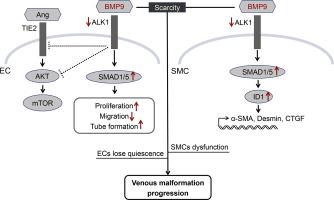Journal of Molecular and Cellular Cardiology ( IF 4.9 ) Pub Date : 2020-07-28 , DOI: 10.1016/j.yjmcc.2020.07.010 Yongyun Li 1 , Qingfeng Shang 1 , Peng Li 1 , Zhi Yang 1 , Jie Yang 1 , Jiahao Shi 1 , Shengfang Ge 1 , Yefei Wang 1 , Xianqun Fan 1 , Renbing Jia 1

|
Venous malformation (VM) is a type of vascular morphogenic defect in humans with an incidence of 1%. Although gene mutation is considered as the most common cause of VM, the pathogenesis of those without gene mutation remains to be elucidated. Here, we aimed to explore the relation of bone morphogenetic protein 9 (BMP9) and development of VM. At first, we found serum and tissue BMP9 expression in VM patients was significantly lower than that in healthy subjects, detected via enzyme-linked immunosorbent assay. Next, with wound healing assay, transwell assay and tube formation assay, we discovered BMP9 could inhibit migration and enhance tube formation activity of human umbilical vein endothelial cells (HUVECs) via receptor activin receptor-like kinase 1 (ALK1). Besides, BMP9 improved the expression of structural proteins alpha-smooth muscle actin (α-SMA) and Desmin in human umbilical vein smooth muscle cells (HUVSMCs) via activation of the SMAD1/5-ID1 pathway, determined by RNA-based next-generation sequencing, qPCR, immunofluorescence and western blotting. Intriguingly, this effect could be blocked by receptor ALK1 inhibitor, SMAD1/5 inhibitor and siRNAs targeting ID1, verifying the BMP9/ALK1/SMAD1/5/ID1/α-SMA pathway. Meanwhile, knocking out BMP9 in C57BL/6 mice embryo led to α-SMA scarcity in walls of lung and mesenteric vessels, as well as walls of small trachea. BMP9−/− zebrafish also exhibited abnormal vascular maturity, indicating a critical role of BMP9 in vascular maturity and remodeling. Finally, a VM mice model revealed that BMP9 might have therapeutic effect in VM progression. Our study discovered that BMP9 might inhibit the occurrence of VM by strengthening the vessel wall and maintaining endothelium quiescence. These findings provide promising evidences of new therapeutic targets that might be used for the management of VM.
中文翻译:

BMP9通过维持内皮细胞静止并通过SMAD1 / 5 / ID1 /α-SMA途径强化血管壁来减轻静脉畸形的发生。
静脉畸形(VM)是人类的一种血管形态发生缺陷,发病率为1%。尽管基因突变被认为是VM的最常见原因,但未阐明基因突变者的发病机理仍有待阐明。在这里,我们旨在探讨骨形态发生蛋白9(BMP9)与VM的发展之间的关系。首先,我们发现通过酶联免疫吸附法检测到,VM患者的血清和组织BMP9表达明显低于健康受试者。接下来,通过伤口愈合测定,transwell测定和管形成测定,我们发现BMP9可通过受体激活素受体样激酶1(ALK1)抑制人脐静脉内皮细胞(HUVECs)的迁移并增强其管形成活性。除了,BMP9通过激活SMAD1 / 5-ID1途径(通过基于RNA的下一代测序确定)来改善人脐静脉平滑肌细胞(HUVSMC)中结构蛋白α-平滑肌肌动蛋白(α-SMA)和结蛋白的表达, qPCR,免疫荧光和蛋白质印迹。有趣的是,该作用可能被受体ALK1抑制剂,SMAD1 / 5抑制剂和靶向ID1的siRNA阻断,从而验证了BMP9 / ALK1 / SMAD1 / 5 / ID1 /α-SMA途径。同时,敲除C57BL / 6小鼠胚胎中的BMP9导致肺和肠系膜血管壁以及小气管壁的α-SMA缺乏。BMP9-/-斑马鱼还表现出异常的血管成熟,表明BMP9在血管成熟和重塑中起关键作用。最后,VM小鼠模型显示BMP9可能对VM进展具有治疗作用。我们的研究发现BMP9可能通过增强血管壁和维持内皮细胞静止来抑制VM的发生。这些发现为可能用于VM管理的新治疗靶标提供了有希望的证据。











































 京公网安备 11010802027423号
京公网安备 11010802027423号